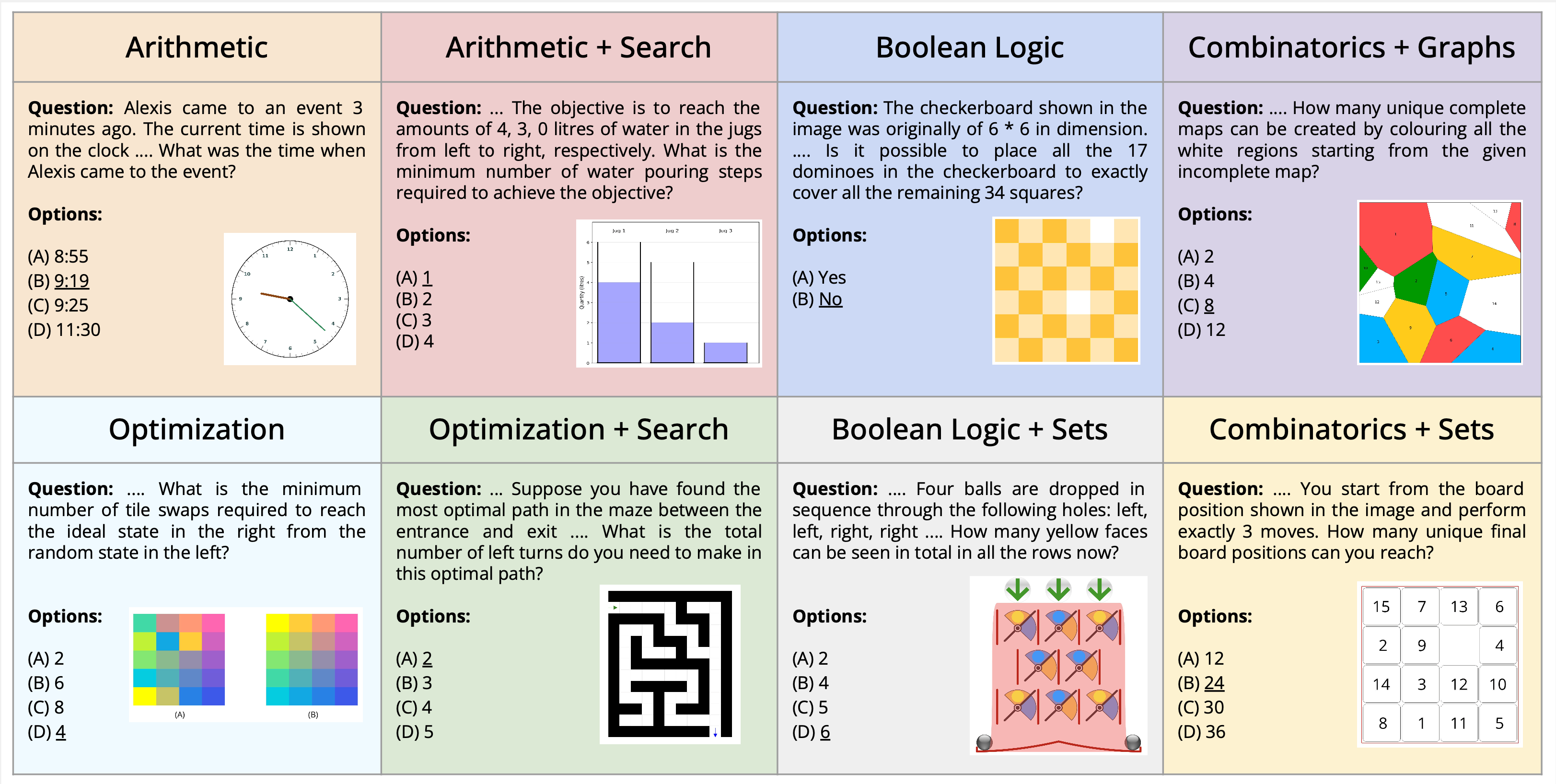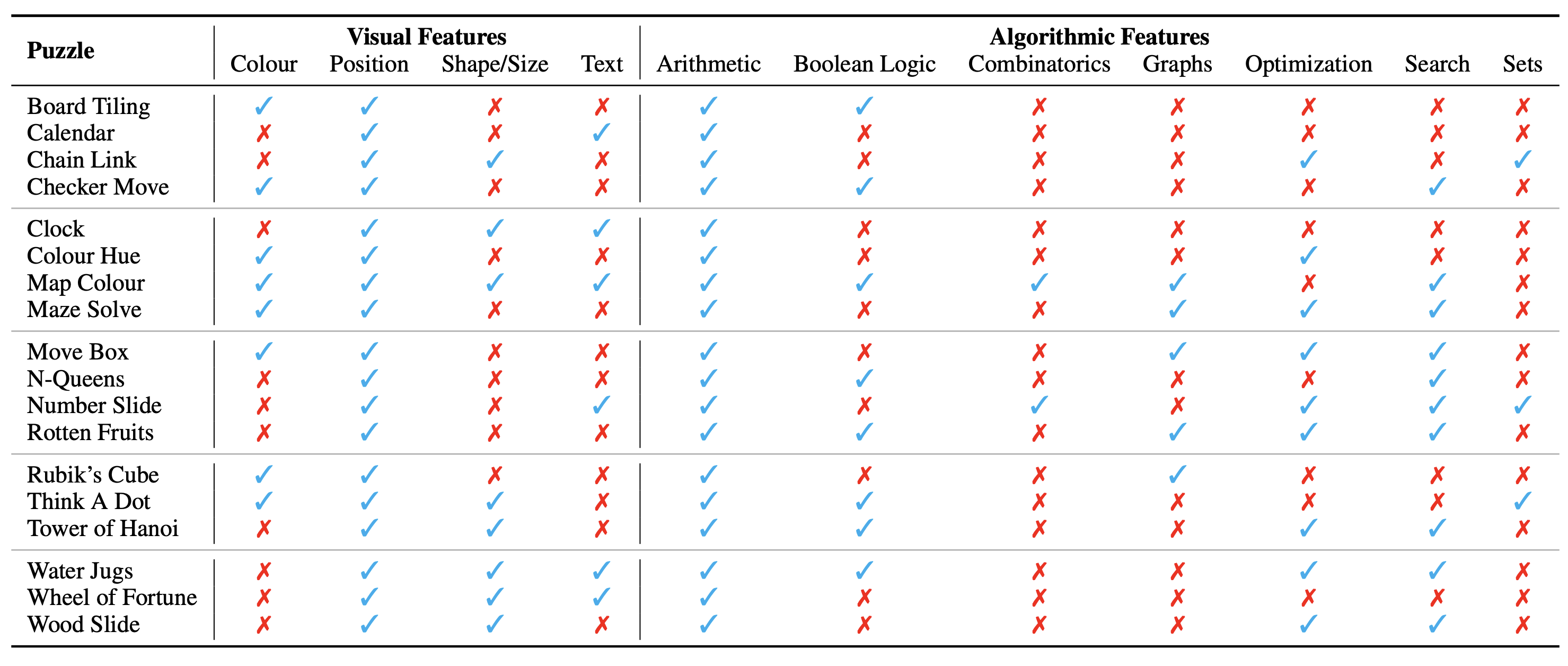🧗 We present a holistic performance of GPT-[n] and o-[n] models on PuzzleVQA and AlgoPuzzleVQA across both Open-Ended and Multiple-Choice settings. Paper
🔥 PuzzleVQA, our new dataset reveals serious challenges of multimodal LLMs in understanding simple abstract patterns. Paper | Website
📣 We are releasing AlgoPuzzleVQA, a novel and challenging dataset for multimodal reasoning! Soon, we will release more multimodal puzzle datasets. Stay tuned! Paper | Website
We are excited to announce the release of two novel VQA datasets centered around puzzles:
- PuzzleVQA: This dataset features abstract visual patterns meticulously crafted to challenge the fundamental reasoning capabilities of MLLMs.
- AlgoPuzzleVQA: Delving deeper into complexity, this dataset presents advanced puzzles that demand algorithmic solutions.
The performance of MLLMs on both datasets is notably deficient, underscoring the pressing need for substantial enhancements in their multimodal reasoning capabilities.
conda create -n puzzle-eval python=3.10 -y
conda activate puzzle-eval
pip install -r requirements.txt
GPT-4-Turbo: Please create a file named gpt4t.json
{"engine": "gpt-4-turbo", "key": "<API_KEY>", "location": "westus", "endpoint": "<ENDPOINT>", "api_version": "2024-08-01-preview"}GPT-4o: Please create a file named gpt4o.json
{"engine": "GPT4o", "key": "<API_KEY>", "location": "westus", "endpoint": "<ENDPOINT>", "api_version":"2024-08-01-preview"}o1: Please create a file named o1-full-high.json
{"engine": "o1-full", "reasoning_effort": "high", "key": "<API_KEY>", "location": "westus", "endpoint": "<ENDPOINT>", "api_version": "2024-12-01-preview"}Our code currently supports inference with Azure OpenAI.
The supported model names are [gpt4t, gpt4o, o1].
# Run evaluation on the "color_hexagon" puzzle in PuzzleVQA with o1
python main.py evaluate --dataset PuzzleVQA --puzzle color_hexagon --question_type open --model_name o1 --output_dir outputs
# Run evaluation on the "wheel_of_fortune" puzzle in AlgoPuzzleVQA with gpt4o
python main.py evaluate --dataset AlgoPuzzleVQA --puzzle wheel_of_fortune --question_type open --model_name gpt4o --output_dir outputs# Run evaluation on the "shape_reflect" puzzle in PuzzleVQA with o1
python main.py evaluate --dataset PuzzleVQA --puzzle shape_reflect --question_type mcq --model_name gpt4t --output_dir outputs
# Run evaluation on the "board_tile" puzzle in AlgoPuzzleVQA with gpt4o
python main.py evaluate --dataset AlgoPuzzleVQA --puzzle board_tile --question_type mcq --model_name o1 --output_dir outputsLarge multimodal models extend the impressive capabilities of large language models by integrating multimodal understanding abilities. However, it is not clear how they can emulate the general intelligence and reasoning ability of humans. As recognizing patterns and abstracting concepts are key to general intelligence, we introduce PuzzleVQA, a collection of puzzles based on abstract patterns. With this dataset, we evaluate large multimodal models with abstract patterns based on fundamental concepts, including colors, numbers, sizes, and shapes. Through our experiments on state-of-the-art large multimodal models, we find that they are not able to generalize well to simple abstract patterns. Notably, even GPT-4V cannot solve more than half of the puzzles. To diagnose the reasoning challenges in large multimodal models, we progressively guide the models with our ground truth reasoning explanations for visual perception, inductive reasoning, and deductive reasoning. Our systematic analysis finds that the main bottlenecks of GPT-4V are weaker visual perception and inductive reasoning abilities. Through this work, we hope to shed light on the limitations of large multimodal models and how they can better emulate human cognitive processes in the future.
PuzzleVQA is available here and also on Huggingface.
The figure below shows an illustration example of components (top) and reasoning explanations (bottom) for abstract puzzles in PuzzleVQA. To construct each puzzle instance, we first define the layout and pattern of a multimodal template, and populate the template with suitable objects that demonstrate the underlying pattern. For interpretability, we also construct ground truth reasoning explanations to interpret the puzzle and explain the general solution stages.
The figure below shows the taxonomy of abstract puzzles in PuzzleVQA with sample questions, based on fundamental concepts such as colors and size. To enhance diversity, we design both single-concept and dual-concept puzzles.
We report the main evaluation results on single-concept and dual-concept puzzles in Table 1 and Table 2 respectively. The evaluation results for single-concept puzzles, as shown in Table 1 reveal notable differences in performance among the open-source and closed-source models. GPT-4V stands out with the highest average score of 46.4, demonstrating superior abstract pattern reasoning on single-concept puzzles such as numbers, colors, and size. It particularly excels in the "Numbers" category with a score of 67.5, far surpassing other models, which may be due to its advantage in math reasoning tasks (Yang et al., 2023). Claude 3 Opus follows with an overall average of 39.4, showing its strength in the "Shapes" category with a top score of 44.5. The other models, including Gemini Pro and LLaVA-13B trail behind with averages of 34.5 and 27.5 respectively, performing similarly to the random baseline on several categories.
In the evaluation on dual-concept puzzles, as shown in Table 2, GPT-4V stands out again with the highest average score of 45.5. It performed particularly well in categories such as "Colors & Numbers" and "Colors & Size" with a score of 56.0 and 55.0 respectively. Claude 3 Opus closely follows with an average of 43.7, showing strong performance in " Numbers & Size" with the highest score of 34.0. Interestingly, LLaVA-13B, despite its lower overall average of 31.1, scores the highest in the "Size & Shapes" category at 39.0. Gemini Pro, on the other hand, has a more balanced performance across categories but with a slightly lower overall average of 30.1. Overall, we find that models perform similarly on average for single-concept and dual-concept patterns, which suggests that they are able to relate multiple concepts such as colors and numbers together.
@misc{chia2024puzzlevqa,
title={PuzzleVQA: Diagnosing Multimodal Reasoning Challenges of Language Models with Abstract Visual Patterns},
author={Yew Ken Chia and Vernon Toh Yan Han and Deepanway Ghosal and Lidong Bing and Soujanya Poria},
year={2024},
eprint={2403.13315},
archivePrefix={arXiv},
primaryClass={cs.CV}
}
We introduce the novel task of multimodal puzzle solving, framed within the context of visual question-answering. We present a new dataset, AlgoPuzzleVQA designed to challenge and evaluate the capabilities of multimodal language models in solving algorithmic puzzles that necessitate both visual understanding, language understanding, and complex algorithmic reasoning. We create the puzzles to encompass a diverse array of mathematical and algorithmic topics such as boolean logic, combinatorics, graph theory, optimization, search, etc., aiming to evaluate the gap between visual data interpretation and algorithmic problem-solving skills. The dataset is generated automatically from code authored by humans. All our puzzles have exact solutions that can be found from the algorithm without tedious human calculations. It ensures that our dataset can be scaled up arbitrarily in terms of reasoning complexity and dataset size. Our investigation reveals that large language models (LLMs) such as GPT4V and Gemini exhibit limited performance in puzzle-solving tasks. We find that their performance is near random in a multi-choice question-answering setup for a significant number of puzzles. The findings emphasize the challenges of integrating visual, language, and algorithmic knowledge for solving complex reasoning problems.
AlgoPuzzleVQA is available here and also on Huggingface.
The configuration of the puzzle/problem is shown as an image, which constitutes its visual context. We identify the following fundamental aspects of the visual context that influence the nature of the puzzles:
- Colour
- Position
- Shape/Size
- Text
We also identify the algorithmic concepts required for solving the puzzles i.e. for answering the questions for the puzzle instances. They are as follows:
- Arithmetic
- Boolean Logic
- Combinatorics
- Graphs
- Optimization
- Search
- Sets
The algorithmic categories are not mutually exclusive, as we need to use two or more categories to derive the answer for most puzzles.
The dataset is available here in these format. We created a total of 18 different puzzles spanning various algorithmic and mathematical topics. Many of these puzzles are popular in various recreational or academic settings.
In total, we have 1800 instances from the 18 different puzzles. These instances are analogous to different test cases of the puzzle, i.e. they have different input combinations, initial and goal states, etc. Reliably solving all the instances would require finding the exact algorithm to use and then applying it accurately. This is akin to how we verify the accuracy of a computer program aiming to solve a particular task through a broad range of test cases.
We currently consider the full dataset as an evaluation-only benchmark. The detailed examples of all puzzles are shown here.
Instructions for generating the dataset can be found here. The number of instances and the difficulty of the puzzles can be scaled arbitrarily to any desired size or level.
The ontological categorization of the puzzles are as follows:
The experimental setup and scripts can be found in the AlgoPuzzleVQA directory.
Please consider citing the following article if you found our work useful:
@article{ghosal2024algopuzzlevqa,
title={Are Language Models Puzzle Prodigies? Algorithmic Puzzles Unveil Serious Challenges in Multimodal Reasoning},
author={Ghosal, Deepanway and Han, Vernon Toh Yan and Chia, Yew Ken and and Poria, Soujanya},
journal={arXiv preprint arXiv:2403.03864},
year={2024}
}




